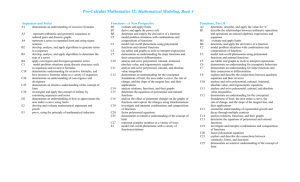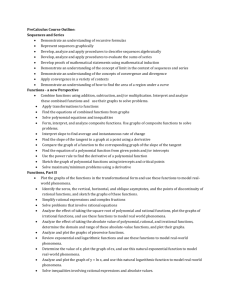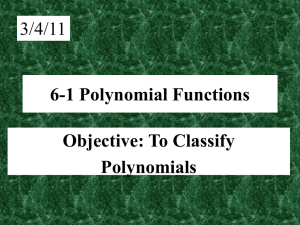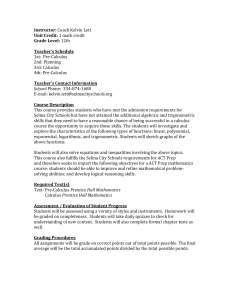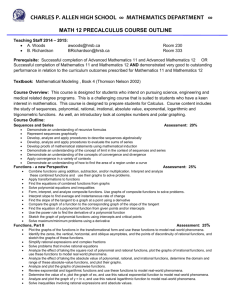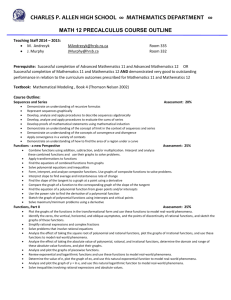PCM12SCO
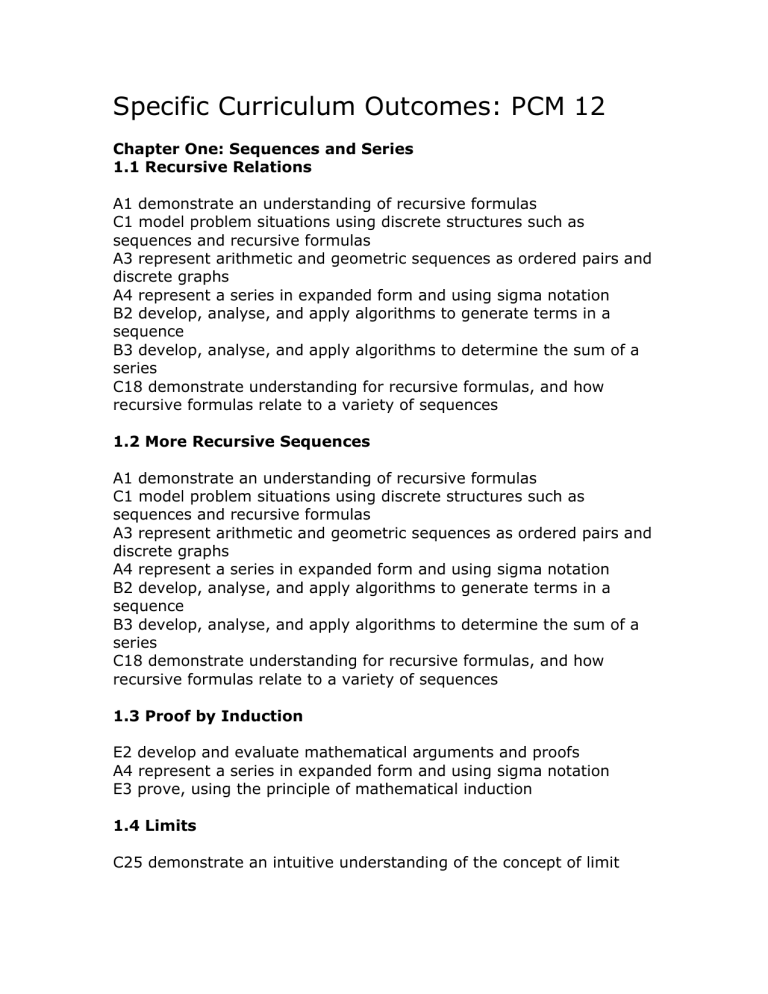
Specific Curriculum Outcomes: PCM 12
Chapter One: Sequences and Series
1.1 Recursive Relations
A1 demonstrate an understanding of recursive formulas
C1 model problem situations using discrete structures such as sequences and recursive formulas
A3 represent arithmetic and geometric sequences as ordered pairs and discrete graphs
A4 represent a series in expanded form and using sigma notation
B2 develop, analyse, and apply algorithms to generate terms in a sequence
B3 develop, analyse, and apply algorithms to determine the sum of a series
C18 demonstrate understanding for recursive formulas, and how recursive formulas relate to a variety of sequences
1.2 More Recursive Sequences
A1 demonstrate an understanding of recursive formulas
C1 model problem situations using discrete structures such as sequences and recursive formulas
A3 represent arithmetic and geometric sequences as ordered pairs and discrete graphs
A4 represent a series in expanded form and using sigma notation
B2 develop, analyse, and apply algorithms to generate terms in a sequence
B3 develop, analyse, and apply algorithms to determine the sum of a series
C18 demonstrate understanding for recursive formulas, and how recursive formulas relate to a variety of sequences
1.3 Proof by Induction
E2 develop and evaluate mathematical arguments and proofs
A4 represent a series in expanded form and using sigma notation
E3 prove, using the principle of mathematical induction
1.4 Limits
C25 demonstrate an intuitive understanding of the concept of limit
C26 investigate and apply the concept of infinity by examining sequences and series
A4 represent a series in expanded form and using sigma notation
B3 develop, analyse, and apply algorithms to determine the sum of a series
C24 demonstrate an understanding of convergence and divergence
B4 apply convergent and divergent geometric series
D2 demonstrate an understanding of how to approximate the area under a curve using limits
Chapter Two: Functions—A New Perspective 2.1 Combining
Functions
C2 model problem situations with combinations and compositions of functions
C14 analyse relations, functions, and their graphs
C5 use tables and graphs as tools to interpret expressions
C19 Investigate and interpret combinations and compositions of functions
C27 represent complex numbers in a variety of ways
2.2 Polynomial Equations and Inequalities
C14 analyse relations, functions, and their graphs
C5 use tables and graphs as tools to interpret expressions
C10 analyse and solve polynomial, rational, irrational, absolute value, and trigonometric equations
C11 analyse and solve polynomial, rational, and absolute value inequalities
E1 model real-world phenomena with a variety of functions/relations
C15 determine the equations of polynomial and rational functions
C20 factor polynomial equations
2.3 Composition of Functions
C2 model problem situations with combinations and compositions of functions
C19 investigate and interpret combinations and compositions of functions
C14 analyse relations, functions, and their graphs
C5 use tables and graphs as tools to interpret expressions
2.4 The Limit of a Rate of Change
E1 model real-world phenomena with a variety of functions/relations
C3 model real-world phenomena using polynomial functions and rational functions
C25 demonstrate an intuitive understanding of the concept of limit
C12 demonstrate an understanding for the conceptual foundations of limit, the area under a curve, the rate of change, and the slope of the tangent line, and their applications
B5 evaluate and apply limits
2.5 The Slope of the Tangent and the Derivative
C7 demonstrate an understanding for slope functions and their connection to differentiation
B8 determine and supply the derivative of a function
C12 demonstrate an understanding for the conceptual foundations of limit, the area under a curve, the rate of change, and the slope of the tangent line, and their applications
B7 derive and apply the power rule
B5 evaluate and apply limits
C14 analyse relations, functions, and their graphs
C5 use tables and graphs as tools to interpret expressions
2.6 Graphs of Polynomial Functions
C14 analyse relations, functions, and their graphs
C16 analyse the effect of parameter changes on the graphs of functions and express the changes using transformations
Chapter Three: Functions, Part II
3.1 Simple Rational Functions
C3 model real-world phenomena using polynomial functions and rational functions
C2 model problem situations with combinations and compositions of functions
C14 analyse relations, functions, and their graphs
C5 use tables and graphs as tools to interpret expressions
C19 investigate and interpret combinations and compositions of functions
C6 demonstrate an understanding for asymptotic behaviour
C10 analyse and solve polynomial, rational, irrational, absolute value, and trigonometric equations
3.2 Rational Functions and Asymptotes
B1 describe the relationships between arithmetic operations and operations on rational algebraic expressions and equations
C14 analyse relations, functions, and their graphs
C5 use tables and graphs as tools to interpret expressions
C6 demonstrate an understanding for asymptotic behaviour
C10 analyse and solve polynomial, rational, irrational, absolute value, and trigonometric equations
C23 explore and describe the connections between continuity, limits, and functions
C25 demonstrate an intuitive understanding of the concept of limit
3.3 Solving Rational Equations
B1 describe the relationships between arithmetic operations and operations on rational algebraic expressions and equations
C15 determine the equations of polynomial and rational functions
C7 demonstrate an understanding for slope functions and their connection to differentiation
C14 analyse relations, functions, and their graphs
C5 use tables and graphs as tools to interpret expressions
C6 demonstrate an understanding for asymptotic behaviour
C3 model real-world phenomena using polynomial functions and rational functions
C11 analyse and solve polynomial, rational, and absolute value inequalities
3.4 Irrational Functions
C14 analyse relations, functions, and their graphs
C5 use tables and graphs as tools to interpret expressions
C19 investigate and interpret combinations and compositions of functions
C10 analyse and solve polynomial, rational, irrational, absolute value, and trigonometric equations
C8 explore and describe the connections between quadratic equations and their inverses
C20 factor polynomial equations
C11 analyse and solve polynomial, rational, and absolute value inequalities
3.5 Absolute—Value Functions
C2 model problem situations with combinations and compositions of functions
C14 analyse relations, functions, and their graphs
C5 use tables and graphs as tools to interpret expressions
C19 investigate and interpret combinations and compositions of functions
C10 analyse and solve polynomial, rational, irrational, absolute value, and trigonometric equations
C11 analyse and solve polynomial, rational, and absolute value inequalities
3.6 Piecewise Functions
C23 explore and describe the connections between continuity, limits, and functions
C25 demonstrate an intuitive understanding of the concept of limit
C12 demonstrate an understanding for the conceptual foundations of limit, the area under a curve, the rate of change, and the slope of the tangent line, and their applications
C2 model problem situations with combinations and compositions of functions
C5 use tables and graphs as tools to interpret expressions
B5 evaluate and apply limits
3.7 Modeling with Exponential and Logarithmic Functions
A2 determine, describe, and apply the value for “e”
B6 determine and apply the derivative of a function
C13 extend the understanding of exponential growth and decay through multiple contexts
C14 analyse relations, functions, and their graphs
C5 use tables and graphs as tools to interpret expressions
C12 demonstrate an understanding for the conceptual foundations of limit, the area under a curve, the rate of change, and the slope of the tangent line, and their applications
B5 evaluate and apply limits
Chapter Four: Trigonometry
4.1 Circular and Periodic Motion
D1 describe and apply the connection between arc length and radian measure
A5 demonstrate an understanding for the use of, and need for, radian measure in the domain of trigonometric functions
C4 model situations with periodic curves
C10 analyse and solve polynomial, rational, absolute value, and trigonometric equations
C14 analyse relations, functions and their graphs
C16 analyse the effect of parameter changes on the graphs of functions and express the changes using transformations
C6 demonstrate an understanding for asymptotic behaviour
4.2 Graphing Trigonometric Functions
C4 model situations with periodic curves
C14 analyse relations, functions and their graphs
C16 analyse the effect of parameter changes on the graphs of functions and express the changes using transformations
C17 explore and analyse the graphs of the reciprocal trigonometric functions
C19 investigate and interpret combinations and compositions of functions
4.3 The General Rotational Matrix
C21 perform various transformations using multiplication of matrices
B8 derive and apply the general rotational matrix (cos 0 -sin 0 sin0 cos
0)
4.4 Trigonometric Identities and Inverse Trigonometric
Functions
C9 examine, interpret, and apply the relationship between trigonometric functions and their inverses
C22 explore and verify trigonometric identities
C10 analyse and solve polynomial, rational, irrational, absolute value, and trigonometric equations
4.5 Combinations of Functions
C2 model problem situations with combinations and compositions of functions
C19 investigate and interpret combinations and compositions of functions
Chapter Five: Numbers Most Complex!
5.1 Number Systems and Complex Numbers
A6 explain the connections between real and complex numbers
C27 represent complex numbers in a variety of ways
B9 apply operations on complex numbers both in rectangular and polar form
C28 construct and examine graphs in the complex and polar planes
E2 develop and evaluate mathematical arguments and proofs
C10 analyse and solve polynomial, rational, irrational, absolute value, and trigonometric equations
5.2 Polar Coordinates
C27 represent complex numbers in a variety of ways
B9 apply operations on complex numbers both in rectangular and polar form
C28 construct and examine graphs in the complex and polar planes
A7 translate between polar and rectangular representation
5.3 Operations Using Polar Coordinates
B9 apply operations on complex numbers both in rectangular and polar form
A7 translate between polar and rectangular representation
B10 develop and apply De Moivre’s Theorem for powers

